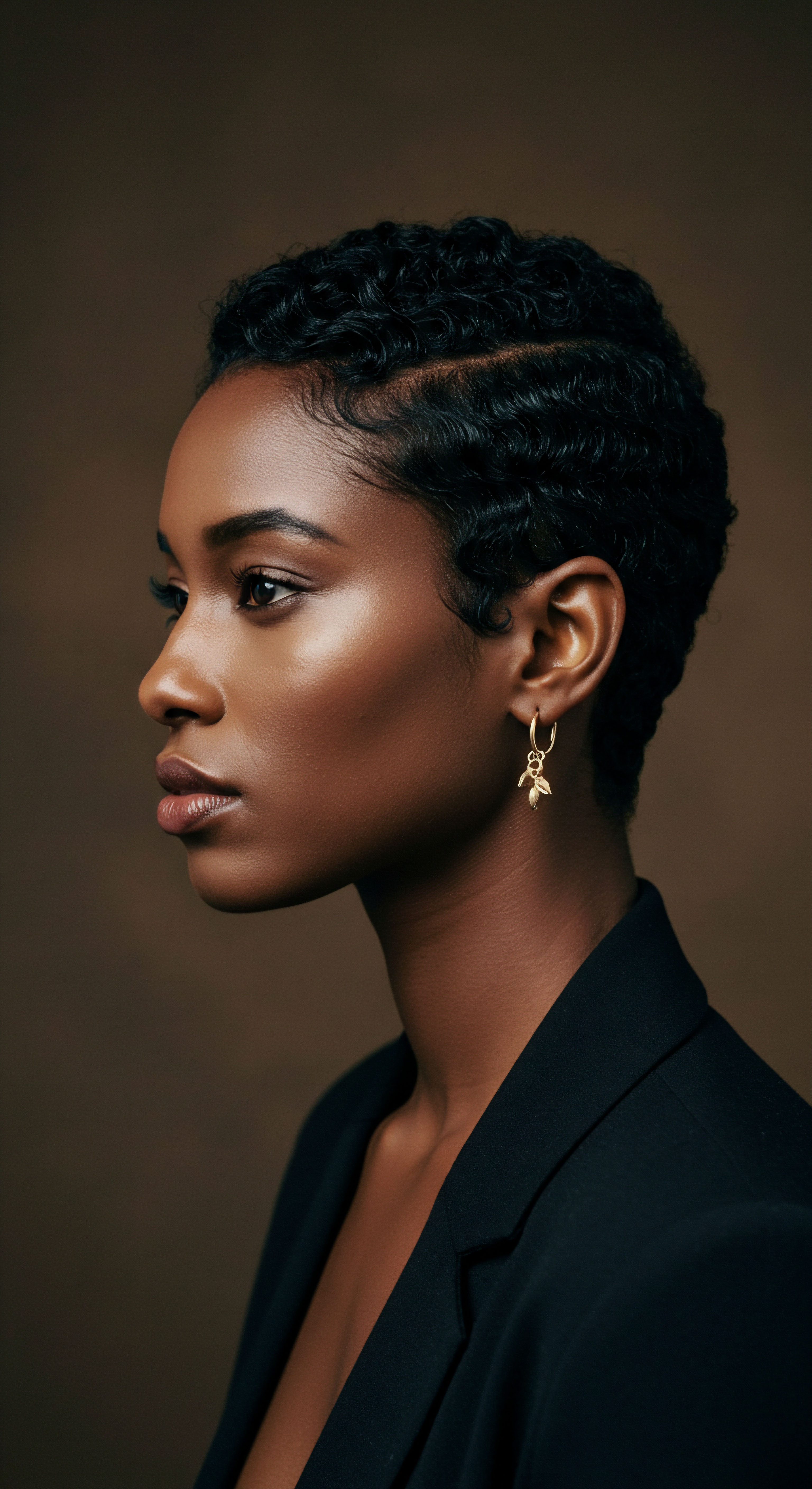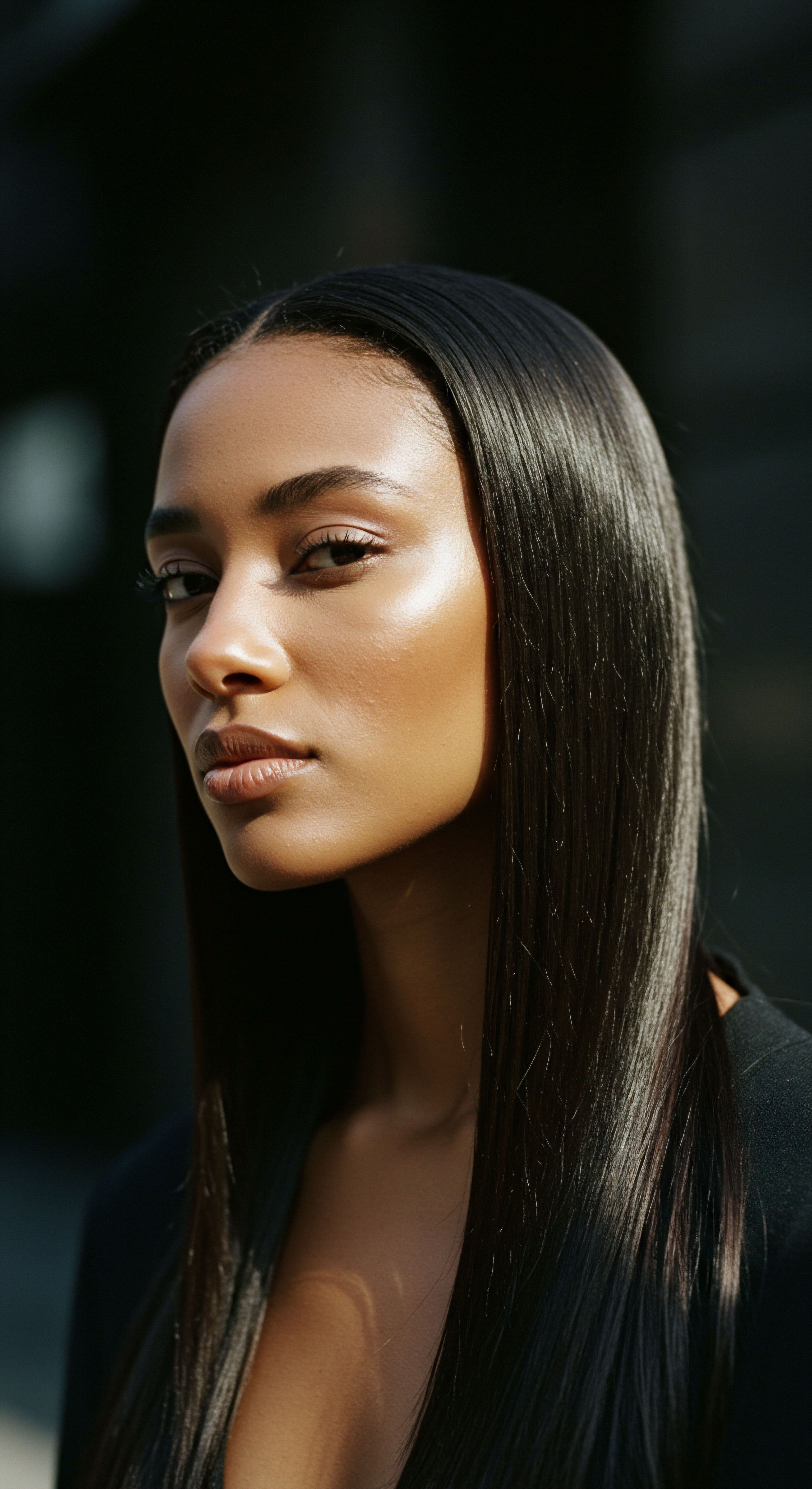
Roots
The ancient world, particularly the vibrant tapestry of Pharaonic Egypt, often beckons us to consider the quiet rhythms of daily life, the unspoken traditions that shaped existence. Among these, the tending of hair held a deeply revered position, not merely as a superficial act of vanity, but as an integral part of hygiene, spiritual belief, and social standing. When we consider the resources Egyptians turned to for their hair’s vitality and appearance, we find ourselves tracing pathways back to the very earth beneath their feet, the fertile banks of the Nile, and the sun-drenched flora of their desert landscape. Their approach to hair care was a testament to an intuitive understanding of natural properties, long before the advent of modern chemistry.
The earliest whispers of their hair wisdom speak of a profound connection to botanical and mineral elements. It was a practice rooted in observation and empirical knowledge, passed down through generations. The very air they breathed, imbued with the scents of blooming papyrus and drying herbs, hinted at the solutions awaiting discovery. From the common laborer to the highest priestess, each individual’s hair was a canvas, meticulously prepared and adorned with nature’s offerings.
Ancient Egyptians meticulously prepared and adorned their hair using nature’s bounty, a practice woven into their daily existence and cultural beliefs.

What Specific Oils Did Egyptians Use?
Among the most cherished natural resources were the various oils, extracted with painstaking care from seeds and fruits. These liquid gold elixirs served as the foundational element of their hair conditioning and styling rituals. The methods of extraction, likely involving simple pressing techniques or maceration, yielded rich, viscous liquids that protected strands from the harsh desert sun and dry winds.
- Castor Oil ❉ A prevalent choice, derived from the castor bean plant, known for its conditioning properties. Ancient texts suggest its use for promoting growth and adding sheen.
- Moringa Oil ❉ Sourced from the moringa tree, this oil was highly valued for its stability and light texture. It possessed excellent moisturizing capabilities and was likely used to soften and protect hair fibers.
- Almond Oil ❉ A gentle emollient, often pressed from sweet almonds. Its nourishing qualities would have made it ideal for soothing the scalp and imparting a soft texture to the hair.
- Balanos Oil ❉ Derived from the fruit of the Balanites aegyptiaca tree, this oil was particularly prized for its aromatic qualities and its ability to lubricate the hair shaft, providing both conditioning and a subtle fragrance.
The application of these oils was not haphazard; it was a deliberate act, often accompanied by massage to stimulate the scalp and ensure even distribution. The goal was to impart a healthy luster, a subtle fragrance, and a manageable texture, qualities highly prized in their aesthetic standards. The sheer variety of oils available speaks to a sophisticated understanding of different botanical benefits, allowing for tailored approaches to hair health.

How Did Herbs and Earth Contribute to Hair Care?
Beyond the realm of oils, the Egyptians skillfully employed a spectrum of herbs and mineral earths, each contributing unique properties to their hair care arsenal. These botanical and geological treasures were not merely decorative additions; they served practical purposes, from cleansing to coloring and even addressing scalp concerns.
Henna, perhaps the most iconic of these plant-derived resources, played a dual role. Its primary use was as a natural dye, imparting rich reddish-brown tones to hair, often seen on mummified remains. Yet, its conditioning properties were equally significant; henna coats the hair shaft, adding strength and gloss. The plant’s leaves were dried, ground into a fine powder, and then mixed with water or other liquids to form a paste for application.
Other botanical additions included Fenugreek, its seeds potentially used in infusions to stimulate hair follicles or to provide a softening effect. Chamomile, with its gentle, soothing properties, might have been incorporated into washes to calm an irritated scalp or to impart subtle golden highlights to lighter hair tones. The precision with which these ingredients were selected and prepared underscores a deep, ancestral wisdom concerning the plant world.
From the earth itself came mineral resources such as Natron, a naturally occurring salt mixture, which served as a cleansing agent. While more famously associated with mummification, its alkaline properties could have been utilized in diluted forms for rudimentary scalp cleansing, helping to remove oils and impurities. Various types of Clay, particularly those rich in minerals, could have been used as purifying masks for the scalp, drawing out toxins and providing a gentle exfoliation. The meticulous preparation of these natural elements, whether through grinding, infusing, or blending, speaks to a holistic approach to hair care that viewed the hair and scalp as interconnected aspects of overall well-being.

Ritual
Stepping beyond the raw materials, we approach the realm of deliberate practice, the daily and ceremonial rhythms that transformed nature’s gifts into tangible benefits for the hair. Ancient Egyptian hair care was far from a simple application; it was a series of thoughtful actions, a ritual that honored the body and expressed cultural values. This practical wisdom, honed over millennia, offers a window into their lives, revealing a meticulous attention to detail and a profound respect for personal presentation. The preparation of these natural resources for application was as vital as the resources themselves, transforming them into effective elixirs and treatments.
The very act of blending and preparing these ingredients was a skill, often passed down within families or among specialized attendants. It involved more than just mixing; it was a process of understanding proportions, textures, and the desired outcome for different hair types and concerns.

How Were Hair Care Resources Prepared?
The transformation of raw natural resources into effective hair treatments involved a series of careful preparation techniques. These methods, though rudimentary by today’s standards, were remarkably effective given the available technology.
For oils, the primary method was likely Cold Pressing, particularly for seeds rich in lipids such as castor or moringa. This process involved crushing the plant material to extract the oil, preserving its delicate properties and beneficial compounds. The resulting oil would then be filtered, possibly through linen cloths, to remove any sediment. For more aromatic or resinous materials, a process of Maceration or enfleurage might have been employed, where the plant matter was steeped in a base oil or fat to transfer its scent and therapeutic qualities.
Herbs, like henna or fenugreek, underwent a process of Drying and Grinding. The leaves or seeds would be sun-dried to remove moisture, preventing spoilage and concentrating their active components. They were then meticulously ground into fine powders using mortars and pestles, ensuring a smooth consistency when mixed with liquids. This fine powder was essential for uniform application and to allow the beneficial compounds to interact effectively with the hair and scalp.
Minerals, such as natron or various clays, also required preparation. Natron, a naturally occurring mineral, might have been dissolved in water to create a cleansing solution, with careful attention paid to dilution ratios to prevent irritation. Clays would have been sifted to remove impurities and then mixed with water or oil to form a pliable paste suitable for scalp masks or hair treatments. The dedication to these preparation steps underscores the value placed on the efficacy and pleasantness of their hair care preparations.
Ancient Egyptians transformed raw natural resources into effective hair treatments through careful pressing, drying, grinding, and blending techniques.

What Daily Practices Defined Ancient Hair Care?
Ancient Egyptian hair care was a daily or near-daily practice, deeply integrated into their personal hygiene and aesthetic routines. The meticulous attention to hair reflected not only a desire for beauty but also practical considerations of cleanliness in a hot, dusty climate.
The routine often began with Cleansing. While true soap was unknown, the use of natron solutions or even finely ground clay mixed with water would have served to remove accumulated dirt and oils from the scalp and hair. This rudimentary cleansing was likely followed by the application of conditioning oils.
After cleansing, oils were applied generously. These preparations, often scented with fragrant resins or essential oils derived from plants like lotus or frankincense, served multiple purposes:
- Moisturizing and Conditioning ❉ The oils helped to seal moisture into the hair shaft, protecting it from dehydration.
- Styling and Hold ❉ Heavier oils and fats provided a natural hold for elaborate hairstyles, including braids, curls, and intricate updos.
- Protection ❉ A layer of oil offered a degree of protection against the harsh desert sun, preventing the hair from becoming brittle and dry.
Combs, crafted from wood, bone, or ivory, were essential tools for detangling and distributing products evenly. Hairpins, often decorative, secured elaborate styles. For those with natural curls or coils, braiding was a common protective style, a practice that minimized tangling and breakage, a testament to their understanding of textured hair needs even in antiquity. The sheer effort and resources dedicated to hair care underscore its cultural significance, where hair was not just an adornment but a statement of identity, status, and health.
| Tool Combs |
| Material Wood, bone, ivory |
| Primary Use Detangling, styling, product distribution |
| Tool Hairpins |
| Material Wood, bone, metal |
| Primary Use Securing hairstyles, adornment |
| Tool Mortars and Pestles |
| Material Stone, wood |
| Primary Use Grinding herbs and minerals into powder |
| Tool Linen Cloths |
| Material Flax fiber |
| Primary Use Filtering oils, general cleaning |
| Tool These simple tools enabled sophisticated hair care practices. |

Relay
Our journey into ancient Egyptian hair care deepens, inviting us to consider not just the materials and methods, but the profound interplay of scientific understanding, cultural significance, and the enduring legacy these practices hold. The quiet echoes of their wisdom reach across millennia, revealing layers of complexity that transcend simple aesthetics. We move beyond the visible acts of cleansing and styling to the very molecules that composed their preparations, and the societal currents that shaped their hair traditions. This section aims to bridge the chasm of time, connecting ancient insights with modern scientific inquiry and cultural resonance.
The study of mummified remains and archaeological findings provides a unique window into the past, allowing us to scientifically investigate the actual substances applied to ancient Egyptian hair. This tangible evidence offers a compelling narrative, one that often corroborates the textual and artistic depictions of their beauty rituals.

What Scientific Evidence Unveils Ancient Egyptian Hair Secrets?
Modern scientific methodologies, particularly those in archaeological chemistry, have begun to peel back the layers of time, revealing the precise chemical signatures of ancient Egyptian hair care products. These investigations provide a tangible, empirical basis for understanding their resource utilization. For example, a significant study by Koller et al. (2018) on hair samples from mummified individuals, including those from the necropolis at Tuna el-Gebel, utilized advanced analytical techniques like gas chromatography-mass spectrometry (GC-MS).
This research identified the presence of complex lipid mixtures, including high concentrations of saturated fatty acids consistent with Animal Fats (likely bovine or ovine), combined with specific plant oils. The findings suggested a deliberate blend of these components to create a highly effective conditioning and styling agent. The presence of fatty acids associated with animal sources, rather than purely plant-based oils, highlights a practical approach to hair care that maximized available resources for optimal results, providing both emollient properties and structural hold for intricate hairstyles.
Such scientific revelations underscore the sophisticated empirical knowledge possessed by the ancient Egyptians. They understood, through observation and trial, which combinations of natural resources yielded the desired effects—whether it was to add sheen, reduce breakage, or maintain complex braided styles. This bio-archaeological approach allows us to move beyond mere speculation, providing concrete evidence of their material choices and their functional understanding of hair biology and product chemistry.
Modern scientific analysis of mummified hair reveals ancient Egyptians combined animal fats and specific plant oils for effective conditioning and styling.

How Did Hair Care Reflect Social Standing and Beliefs?
Beyond the purely physical benefits, hair care in ancient Egypt was deeply interwoven with social status, spiritual beliefs, and even protective functions. The resources chosen, and the elaborate styles created, often communicated wealth, purity, and connection to the divine.
The finest oils and rarest perfumes, often imported through extensive trade networks, would have been accessible primarily to the elite. Ingredients like precious resins or specific floral extracts, perhaps from the blue lotus, would have been indicative of high social standing. The sheer time and effort dedicated to maintaining elaborate wigs and natural hair styles also spoke volumes about one’s leisure and resources. Hair was not just adorned; it was protected, with practices like braiding and the use of wigs serving as practical solutions against environmental elements and as symbols of status.
Hair also held spiritual significance. It was seen as a conduit, a connection to the divine, and its care was sometimes linked to rituals of purification and offerings to deities. The elaborate styles depicted in tomb paintings and on statues were not just aesthetic choices; they were often symbolic, reflecting religious narratives or the wearer’s role in society. This profound connection between personal care and the sacred elevates ancient Egyptian hair practices beyond mere cosmetic routines, positioning them as integral components of a rich cultural fabric.
The resilience and ingenuity of ancient Egyptian hair care practices resonate even today, particularly within textured hair communities. The understanding of natural ingredients, the importance of protective styling, and the holistic view of hair as a vital part of one’s identity—these are principles that echo in contemporary natural hair movements. The ancient Egyptians, in their deep respect for nature’s bounty and their meticulous application of its gifts, laid down a foundational understanding of hair care that continues to offer lessons in conscious, earth-centered beauty.

Reflection
As we step back from the meticulous details of ancient Egyptian hair care, a profound sense of continuity washes over us. The whispers of the Nile, the warmth of the desert sun, and the scent of crushed botanicals seem to linger, inviting us to recognize the enduring wisdom held within these age-old practices. Their intimate connection with the earth, their understanding of its subtle offerings for hair’s vitality, transcends the mere passage of time.
It reminds us that true care often lies in simplicity, in observing what nature provides, and in applying it with intention and respect. The echoes of their dedication to hair as a symbol of health, status, and spirit continue to resonate, offering a gentle reminder that our own hair journeys are part of a much grander, more ancient narrative.

References
- Koller, J. Schiestl, R. & Schoske, A. (2018). “Archaeological Chemistry of Ancient Egyptian Hair ❉ A Review.” In R. Schiestl & A. Schoske (Eds.), Beauty and Cosmetics in Ancient Egypt (pp. 200-215). Munich ❉ Hirmer Verlag.
- Lucas, A. (1930). Ancient Egyptian Materials & Industries. London ❉ Edward Arnold & Co.
- Manniche, L. (1999). Music and Medicine in Ancient Egypt. London ❉ British Museum Press. (Covers plants and their uses)
- Germer, R. (1997). Ancient Egyptian Mummies ❉ A Very Short Introduction. Oxford ❉ Oxford University Press. (Relevant for hair preservation aspects)
- Brewer, D. J. & Teeter, E. (1999). Egypt and the Egyptians. Cambridge ❉ Cambridge University Press. (Provides cultural context for daily life and beauty)